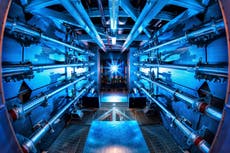Nuclear fusion breakthrough holds promise of ‘near-limitless’ clean energy
For 70 years, scientists have tried to replicate the same energy process that powers the sun
The United States has announced a nuclear fusion breakthrough, a historic step towards the promise of “near-limitless” clean energy.
“It will go down in the history books,” said energy secretary Jennifer Granholm on Tuesday in Washington DC alongside scientists from the Lawrence Livermore National Laboratory (LLNL) in California.
For around 70 years, thousands of scientists and engineers have attempted to replicate the energy process of atoms fusing together that powers the sun and other stars.
It is an enormously complex – and expensive – process which is highly unstable due to the high temperatures and pressures involved.
Now, for the first time, the California lab team achieved a “net energy gain” – producing more energy in a fusion reaction than was used to ignite it. The test involved bombarding a pellet of hydrogen plasma with the world’s largest laser.
On 5 December, a team at LLNL’s National Ignition Facility (NIF) conducted the first controlled-fusion experiment in history to reach the milestone, also known as a “scientific energy breakeven”.
The team then spent a week analysing test data and putting it to peer review by other fusion academics before the breakthrough was made public.
It was confirmed that the experiment surpassed the fusion threshold by delivering 2.05 megajoules (MJ) of energy to the target, resulting in 3.15 MJ of energy output.
Scientists heralded the achievement but said there were decades of work to be done before inertial fusion energy (or IFE) could be powering our everyday lives.
However LLNL director Dr Kim Budil said on Tuesday that while there are “very significant hurdles” in science and technology to reaching commercial nuclear fusion, it could happen in a “few” decades as opposed to 60 or 70 years as had previously been believed.
“The pursuit of fusion ignition in the laboratory is one of the most significant scientific challenges ever tackled by humanity, and achieving it is a triumph of science, engineering, and most of all, people,” Dr Budil said.
The fusion breakthrough has the potential to significantly impact the trajectory of the climate crisis – driven by the planet-heating greenhouse gas emissions from burning fossil fuels. Fusion does not produce greenhouse gases nor long-lived radioactive waste.
“This astonishing scientific advance puts us on the precipice of a future no longer reliant on fossil fuels but instead powered by new clean fusion energy,” senate majority leader Charles Schumer said on Tuesday.
Dr Robbie Scott, of the Science and Technology Facilities Council’s Central Laser Facility Plasma Physics Group who contributed to this research, called it a “momentous achievement after 50 years of research into Laser Fusion”.
“Fusion has the potential to provide a near-limitless, safe, clean, source of carbon-free baseload energy,” he said.
“It cannot be overstated what a huge breakthrough this is for laser fusion research.”
The US Department of Energy is currently restarting a broad-based, coordinated IFE program in the US. “Combined with private-sector investment, there is a lot of momentum to drive rapid progress toward fusion commercialisation,” the LLNL public affairs office said in a statement.
Join our commenting forum
Join thought-provoking conversations, follow other Independent readers and see their replies
Comments


Bookmark popover
Removed from bookmarks